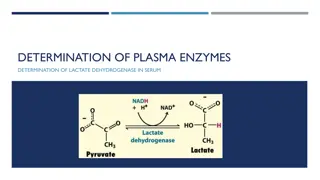
Overview of Lactate Dehydrogenase (LDH) Test and Clinical Significance
Learn about the quantitative determination of lactate dehydrogenase (LDH), including its types, principle, clinical significance, and testing procedure. LDH is an enzyme crucial for energy production in cells and is found in various organs and tissues. High LDH levels can indicate liver disease, heart issues, kidney problems, and more, while low levels are rare. Understand the importance of LDH testing and interpretation in diagnosing health conditions.
Download Presentation

Please find below an Image/Link to download the presentation.
The content on the website is provided AS IS for your information and personal use only. It may not be sold, licensed, or shared on other websites without obtaining consent from the author. If you encounter any issues during the download, it is possible that the publisher has removed the file from their server.
You are allowed to download the files provided on this website for personal or commercial use, subject to the condition that they are used lawfully. All files are the property of their respective owners.
The content on the website is provided AS IS for your information and personal use only. It may not be sold, licensed, or shared on other websites without obtaining consent from the author.
E N D
Presentation Transcript
Lab2 Lactate Dehydrogenase Daheeya AlEnazi Quantitative determination of lactate dehydrogenase LDH
Why do we use it? LDH is an enzyme that helps the process of turning sugar into energy for your cells to use. it is present in many kinds of organs and tissues throughout the body, including the liver, heart, pancreas, kidneys, skeletal muscles, brain, and blood cells.
Types of LDH Isoenzymes Lactate dehydrogenase test: Types, Procedure Results#Overview1#Overview1 - Internet Explorer
principle LDH catalyses the reduction of pyruvate by NADH: Pyruvate+ NADH+ H+ LDH L-lactate+ NAD+ The rate of decrease in concentration of NADPH, measured photometircally, is proportional to the catalytic concentration of LDH present in sample.
Clinical significance When illness or injury damages your cells, LDH may be released into the bloodstream, causing the level of LDH in your blood to rise. High LDH: Liver disease, heart (MI), kidney diseae, skeletal muscle(musclur dystrophy) and erythrocytes(Anaemia) Abnormally low LDH levels occur only rarely and usually aren t harmful. Clinical diagnosis should not be made on single test result.
Procedure Mix, incubate for 1 minute. Read initial absorbance (A) of the sample, start the stopwatch And read absorbances at 1min intervals thereafter for 3 min. Calculate the difference between absorbances and the average absorbance differences per minute ( A/min)
Calculation A/min x 4925 = LDH U/L Normal Range: 120-240 U/L







